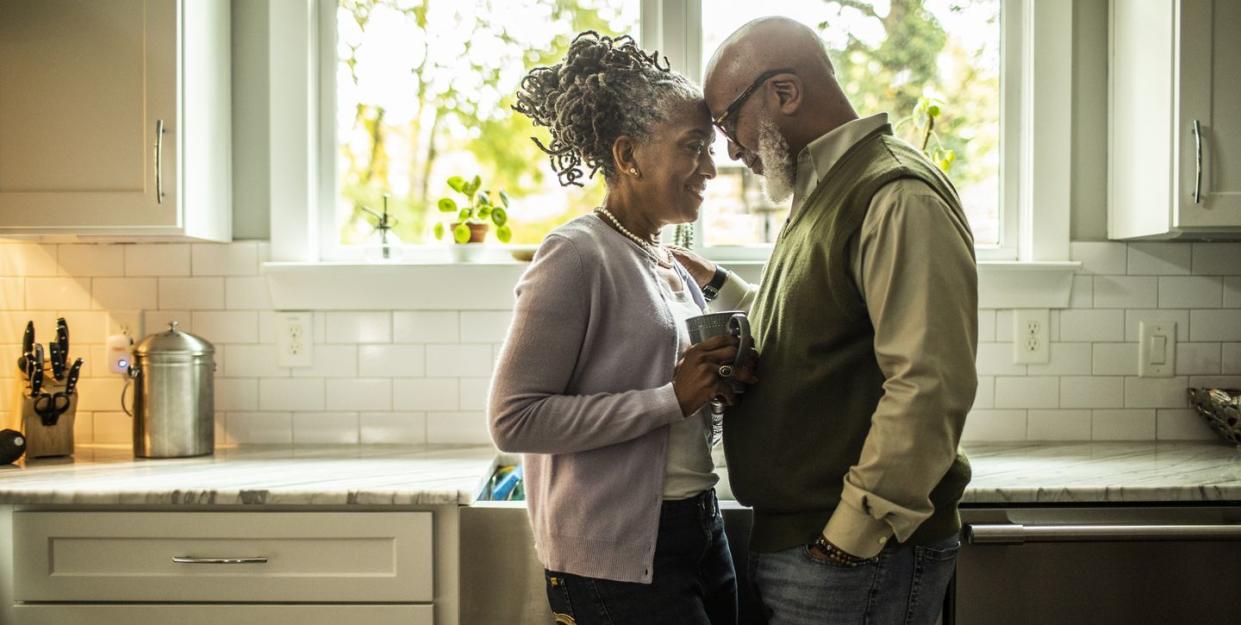What Your Attachment Style Says About Your Relationship, According to a Therapist

- Oops!Something went wrong.Please try again later.
"Hearst Magazines and Yahoo may earn commission or revenue on some items through these links."
If relationship anxiety or an argument with a partner has ever brought up childhood trauma—say, distressing treatment from a parent or a time you felt abandoned—you’re not alone, and you likely have what’s known as an insecure attachment style.
Attachment styles are a product of attachment theory, a psychological school of thought that says early caregiving bonds (i.e. those with parents and guardians) have a hand in the way we navigate adult relationships—romantic and not. Over time, researchers have established four different attachment styles that most people fall into. Read on to learn more about them, and how knowing your own may help you better understand your love life.
What is attachment theory?
Attachment theory was originally introduced in the mid 1900s by psychologist John Bowlby, who defined attachment as “lasting psychological connectedness between human beings” in his book Attachment and Loss. The theory was later famously expanded upon by psychologist Mary Ainsworth’s “Strange Situation” study, which observed children’s reactions to being reunited with their mothers after a short separation.
In essence, attachment theory explores how the fulfillment (or lack thereof) of a child’s needs “affects a person and their relationships for the rest of their lives,” explains Juliet Lam Kuehnle, a national board-certified counselor, therapist, and author of Who You Callin’ Crazy?!: The Journey from Stigma to Therapy.
“We are wired to connect with others and so, as infants, as we seek safety, security, and connection from our caregivers, we learn how to relate, what we can expect, and we form a concept of self in relation to all of this,” Kuehnle adds.
The phenomenon has been studied for how it contributes to peoples’ emotional, social, psychological, and evolutionary development. Below are the four different attachment styles outlined by Bowlby, Ainsworth, and others.
Secure attachment
Simply put, those with secure attachment styles experienced healthy relationships with their caregivers. More specifically, they felt seen and consoled amidst adversity. “If caregivers were available consistently and warmly and the child felt valued, secure, and validated, the child is more likely to feel secure attachment and grow up to have healthier and reciprocal relationships,” says Kuehnle.
Research shows those with secure attachment styles also have stronger emotional regulation as adults, as well as higher self-esteem, social skills, a bigger disposition for empathy.
An easy way to know if you’re secure (and not one of the other three insecure styles), is to ask a simple question used by authors and therapists Milan and Kay Yerkovich in their book How We Love: Discover Your Love Style, Enhance Your Marriage: Can you recall being comforted as a child after a time of emotional distress? If so, you’re likely secure, if not, there’s a chance you (and 75% of others, per the Yerkovichs’ research) fall into one of the three following insecure styles.
Ambivalent or anxious attachment (insecure)
An anxious (also called ambivalent) attachment style builds from inconsistent caregiving, explains Kuehnle, where guardians are present for a child at times and not at others. Those with anxious attachment “may be more likely to be codependent in relationships and feel responsibility for others’ feelings,” Kuehnle says. “They tend to worry about the person they’re in relationship with abandoning them or they need a lot of reassurance to truly feel connected.”
In Ainsworth’s “Strange Situation,” anxious attached children showed stress when their parent was absent, but weren’t soothed upon their return—instead vacillating between frustration, anger, and clinginess.
Avoidant attachment (insecure)
Avoidant attachment speaks for itself—it’s a product of a caregiver who was “distant, unavailable, or neglectful,” says Kuehnle, which results in a child avoiding closeness to not only said caregiver, but in most meaningful relationships. “These people may grow up to believe they need to be fiercely independent because they can’t rely on, or trust, others,” explains Kuehnle. “It is really hard for them to commit or build emotional intimacy.”
Research shows that highly avoidant people typically have negative views of romantic partners and usually positive, but sometimes brittle, views of self.
Disorganized attachment (insecure)
Disorganized attachment, which was later added to Ainsworth’s original three styles by researchers Mary Main and Judith Solomon, is a category that envelops the “Strange Situation” children who didn’t fall into the former three styles by exhibiting a mixture of anxious and avoidant tendencies. It was deduced that those behaviors stemmed from childhood abuse, neglect, or trauma. “These children, who were fearful of their parents, may be more likely to have relationships that are quite unpredictable and disregulated,” explains Kuehnle.
How to discover your attachment style
Although there are various quizzes online that can help you uncover your attachment style, Kuehnle advises proceeding with caution. After all, these categories are merely guideposts for relationship navigation, and could never encompass the nuances of every individual and relationship.
“It’s important to note that we don’t just have one set attachment style forever,” she adds. “We may fall within a range of the various styles and our style can shift, meaning we may exhibit different styles based on who we’re in relationship with. And, the best news is, those with insecure attachment styles can rewire towards secure attachment, or what’s called earned security.”
Kuehnle recommends therapy for anyone looking to learn more about their attachment style and how it affects their relationships. “It’s truly best to have a trained, licensed professional administer an assessment,” she says. “Through this work, you can unlearn old beliefs or unhealthy patterns and work to develop more secure, healthy attachment.”
You Might Also Like

